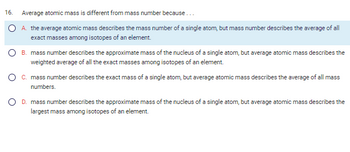
Chemistry
10th Edition
ISBN: 9781305957404
Author: Steven S. Zumdahl, Susan A. Zumdahl, Donald J. DeCoste
Publisher: Cengage Learning
expand_more
expand_more
format_list_bulleted
Concept explainers
Question
thumb_up100%

Transcribed Image Text:### Understanding the Difference Between Average Atomic Mass and Mass Number
The question explores how average atomic mass and mass number differ:
**Question 16**: Average atomic mass is different from mass number because . . .
- **A.** The average atomic mass describes the mass number of a single atom, but mass number describes the average of all exact masses among isotopes of an element.
- **B.** Mass number describes the approximate mass of the nucleus of a single atom, but average atomic mass describes the weighted average of all the exact masses among isotopes of an element.
- **C.** Mass number describes the exact mass of a single atom, but average atomic mass describes the average of all mass numbers.
- **D.** Mass number describes the approximate mass of the nucleus of a single atom, but average atomic mass describes the largest mass among isotopes of an element.
**Explanation**:
- The **mass number** specifically refers to the total number of protons and neutrons in the nucleus of a single atom, often rounded to the nearest whole number.
- The **average atomic mass** considers the average of all isotopes' masses, weighted by their natural abundance.
**Correct Choice: B** - This option accurately reflects that while the mass number refers to a single nucleus's protons and neutrons, average atomic mass is a weighted average of all isotopes' exact masses.
Expert Solution
arrow_forward
Step 1
The atomic number of an atom is the number of protons present in the atom. For a neutral atom, the number of electrons is also the same as the atomic number. Hence, we can say that:
Atomic number = number of protons = number of electrons
The mass number of the atom is the sum of the protons and neutrons present in the atom.
The mass number is = number of protons + number of neutrons
Step by stepSolved in 3 steps

Knowledge Booster
Learn more about
Need a deep-dive on the concept behind this application? Look no further. Learn more about this topic, chemistry and related others by exploring similar questions and additional content below.Similar questions
- + In a sample of 47,500 silver atoms is was discovered that 35.8% of them had a mass of 107.35 amu and the rest has a mass of 109.27 amu. amount of each isotope? 79 and a. How many atoms have a mass of 107.35? b. What is the % of atoms with a mass of 109.27? C. What is the atomic mass of this sample?arrow_forwardQUESTION 31 A substance composed of two or more elements in a fixed, definite proportion is O A. a homogeneous mixture B. a heterogeneous mixture O C. a compound O D. a solution QUESTION 32 Bonds are made by sharing or transferring by the atoms. O A. protons O B. electrons OC. neutrons O D. photons QUESTION 33 Potassium (K) is a/an O A. noble gas OB. transition metal O C. alkali metal O D. alkaline earth metalarrow_forward"For nitrogen-14 with a charge of 1, the number of protons are type your answer... the number of neutrons are type your answer... electrons are type your answer... and the number ofarrow_forward
- Calculate the number of neutrons of neutrons 209. Bi. Xarrow_forwardPlease help me answer questions 3 & 65. 3. Oxidation is A. the loss of protons by an atom or molecule. B. the gain of oxygen by a cell. C. the loss of electrons from an atom or molecule. D. the loss of oxygen from a cell. E. The gain of electrons by an atom or molecule. 65. The atomic number of an atom or element is the number of A. neutrons in the nucleus. B. protons in the orbitals. C. Electrons in the nucleus. D. Neutrons in the orbitals E. Protons in the nucleus.arrow_forwardTrue or False...and why? a.) If you change number of protons, you have isotopes of an element b.) If you change number of neutrons, ions are created c.) If you change number of electrons, you have a different elementarrow_forward
- I dont know how to do this questionarrow_forwardPlease help thanks!arrow_forwardThe relative atomic masses of elements are seldom whole numbers because A. atoms of some elements have different atomic numbers. B. atoms of some elements have different masses. C. atoms of some elements have different numbers of electrons. D. atoms of some elements can form ions.arrow_forward
arrow_back_ios
arrow_forward_ios
Recommended textbooks for you
 ChemistryChemistryISBN:9781305957404Author:Steven S. Zumdahl, Susan A. Zumdahl, Donald J. DeCostePublisher:Cengage Learning
ChemistryChemistryISBN:9781305957404Author:Steven S. Zumdahl, Susan A. Zumdahl, Donald J. DeCostePublisher:Cengage Learning ChemistryChemistryISBN:9781259911156Author:Raymond Chang Dr., Jason Overby ProfessorPublisher:McGraw-Hill Education
ChemistryChemistryISBN:9781259911156Author:Raymond Chang Dr., Jason Overby ProfessorPublisher:McGraw-Hill Education Principles of Instrumental AnalysisChemistryISBN:9781305577213Author:Douglas A. Skoog, F. James Holler, Stanley R. CrouchPublisher:Cengage Learning
Principles of Instrumental AnalysisChemistryISBN:9781305577213Author:Douglas A. Skoog, F. James Holler, Stanley R. CrouchPublisher:Cengage Learning Organic ChemistryChemistryISBN:9780078021558Author:Janice Gorzynski Smith Dr.Publisher:McGraw-Hill Education
Organic ChemistryChemistryISBN:9780078021558Author:Janice Gorzynski Smith Dr.Publisher:McGraw-Hill Education Chemistry: Principles and ReactionsChemistryISBN:9781305079373Author:William L. Masterton, Cecile N. HurleyPublisher:Cengage Learning
Chemistry: Principles and ReactionsChemistryISBN:9781305079373Author:William L. Masterton, Cecile N. HurleyPublisher:Cengage Learning Elementary Principles of Chemical Processes, Bind...ChemistryISBN:9781118431221Author:Richard M. Felder, Ronald W. Rousseau, Lisa G. BullardPublisher:WILEY
Elementary Principles of Chemical Processes, Bind...ChemistryISBN:9781118431221Author:Richard M. Felder, Ronald W. Rousseau, Lisa G. BullardPublisher:WILEY

Chemistry
Chemistry
ISBN:9781305957404
Author:Steven S. Zumdahl, Susan A. Zumdahl, Donald J. DeCoste
Publisher:Cengage Learning

Chemistry
Chemistry
ISBN:9781259911156
Author:Raymond Chang Dr., Jason Overby Professor
Publisher:McGraw-Hill Education

Principles of Instrumental Analysis
Chemistry
ISBN:9781305577213
Author:Douglas A. Skoog, F. James Holler, Stanley R. Crouch
Publisher:Cengage Learning

Organic Chemistry
Chemistry
ISBN:9780078021558
Author:Janice Gorzynski Smith Dr.
Publisher:McGraw-Hill Education

Chemistry: Principles and Reactions
Chemistry
ISBN:9781305079373
Author:William L. Masterton, Cecile N. Hurley
Publisher:Cengage Learning

Elementary Principles of Chemical Processes, Bind...
Chemistry
ISBN:9781118431221
Author:Richard M. Felder, Ronald W. Rousseau, Lisa G. Bullard
Publisher:WILEY